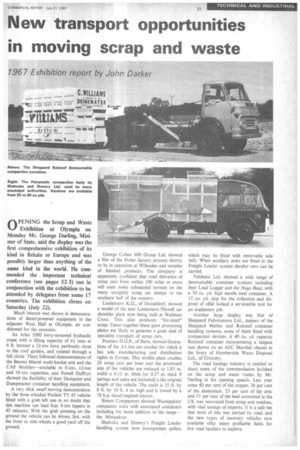New transport opportunities in moving scrap and waste
Page 33

If you've noticed an error in this article please click here to report it so we can fix it.
0 PENING the Scrap and Waste Exhibition at Olympia on Monday Mr. George Darling, Minister of State, said the display was the first comprehensive exhibition of its kind in Britain or Europe and was possibly larger than anything of the same kind in the world. He commended the important technical conference (see pages 52-3) run in conjunction with the exhibition to be attended by delegates from some 17 countries. The exhibition closes on Saturday (July 22).
Much interest was shown in demonstrations of diesel-powered equipment in the adjacent West Hall at Olympia, air conditioned for the occasion.
An Atlas 5000 lorry-mounted hydraulic crane with a lifting capacity of 6; tons at 6 ft. hoisted a 2+-ton lorry perilously close to the roof girders, and rotated through a full circle. There followed demonstrations of the Bennes Marrel multi-bucket unit and the CAF Multilev—available in 8-ton, 12-ton and 16-ton capacities, and Powell Duffryn showed the flexibility of their Dumpster and Dumpmaster container handling equipment.
A very slick swarf-moving demonstration by the three-wheeled Poclain TY 45 vehicle fitted with a grab left one in no doubt that this machine can load four 9-ton tippers in 45 minutes. With the grab pressing on the ground the vehicle can be driven, fast, with the front or side wheels a good yard off the ground. George Cohen 600 Group Ltd. showed a film of the Proler factory process shortly to be in operation at Willesden and samples of finished products. The company is apparently confident that road deliveries of scrap cars from within 100 miles or more will soon make substantial inroads on the many unsightly scrap car dumps in the southern half of the country.
Lindemann KG., of Dusseldorf, showed a model of the new Lindemann /Newell car shredder plant now being .built at Waltham Cross. This also produces "fist-sized" scrap. Taken together these giant processing plants are likely to generate a great deal of specialist transport of scrap cars.
Preeimo D.O.P., of Paris, showed illustrations of the Al-Jon car crusher for which it has sole manufacturing and distribution rights in Europe. This mobile plant crushes 20 scrap cars per hour and the processed size of the vehicles are reduced to 1.83 m. width x 0.15 m. thick (or 0.27 m. thick if springs and axles are included) x the original length of the vehicle. The outfit is 35 ft. by 8 ft. by 10 ft. 6 in. high and is towed by a 70 h.p. diesel-engined tractor.
Simon Compactors showed Wastepaktor compactor units with associated containers including the latest addition to the range the Minipaktor.
Shelvoke and Drewry's Freight Loader handling system now incorporates pallets which may be fitted with removable side rails. When auxiliary arms are fitted to the Freight Loader system derelict cars can be carried.
Telehoist Ltd. showed a wide range of demountable container systems including their Load Lugger and the Huge Haul, with a 30 cu. yd. high tensile steel container. A 12 Cu. yd. skip for the collection and disposal of offal looked a serviceable tool for an unpleasant job.
Another large display was that of Sheppard Fabrications Ltd., makers of the Sheppard Meiller and Rolonof container handling systems, some of them fitted with compaction devices. A 40 Cu. yd. capacity Rolonof container incorporating a tailgate was shown on an AEC Marshal chassis in the livery of Humberside Waste Disposal Ltd., of Grimsby.
The road haulage industry is entitled to share some of the commendation lavished on the scrap and waste trades by Mr. Darling in his opening speech. Last year some 40 per cent of the copper, 36 per cent of the aluminium, 23 per cent of the zinc and 51 per cent of the lead consumed in the UK was recovered from scrap and residues, with vital savings of imports. It is a safe bet that most of this was carried by road, and the new types of recovery vehicles now available offer many profitable fields for live road hauliers to explore.












































































































